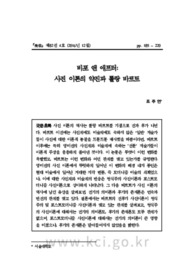

PARTNER
검증된 파트너 제휴사 자료
비포 앤 애프터: 사진 이론의 약진과 롤랑 바르트 (Before and After: The Rise of Photography Theories and Roland Barthes)
36 페이지
최초등록일 2025.06.06
최종저작일
2016.12

-
미리보기
서지정보
· 발행기관 : 한국미학회
· 수록지 정보 : 美學(미학) / 82권 / 4호 / 185 ~ 220페이지
· 저자명 : 조주연
초록
사진 이론의 역사는 롤랑 바르트를 기점으로 전과 후가 나뉜다. 바르트 이전에는 사진계에도 미술계에도 속하지 않은 ‘일반’ 저술가들이 사진에 대한 이론적 통찰을 드문드문 제시했을 따름이라면, 바르트 이후에는 특히 영미권의 사진계와 미술계에 속하는 ‘전문’ 저술가들이 이론적 주장을 촘촘하게 쏟아낸 것이다. 이 논문은 무엇이 이런 변화를 촉발했고, 바르트는 이런 변화와 어떤 관계를 맺고 있는가를 규명한다. 영미권의 사진 이론에서 뚜렷하게 일어난 이 변화의 배경 내지 동인은 현대 미술에서 일어난 거대한 지각 변동, 즉 모더니즘 미술의 쇠퇴였으나, 이에 대한 사진계와 미술계의 반응은 형식주의 사진이론과 포스트모더니즘 사진이론으로 상이하게 나타났다. 그 다음 바르트가 사진 이론의 역사에 남긴 유산을 살펴보면, 전기의 의미론과 후기의 존재론은 연속과 반전의 관계를 맺고 있다. 결론에서는 바르트의 전후기 사진이론이 형식주의 및 포스트모더니즘 사진이론과 맺고 있는 관계를 살펴보고, 형식주의 사진이론에 대해서는 전기의 의미론도, 후기의 존재론도 모두 관계가 없으며, 포스트모더니즘 사진이론에 대해서는 전기의 의미론이 큰 영향을 미쳤으나, 후기의 존재론은 받아들여지지 않았음을 밝힌다.영어초록
The invention of photography occurred in 1839, but its theorization began almost a century later when photography became a medium of serious attention by several writers in 1920s. The progress was, however, very slow, and all of a sudden the rush of photography theory came out from 1960s through 1970s. Both the photographic community and the art world in the USA and the UK began to produce professional theories of photography. This change had the same origin which was the decline of modernism in art, but the responses to it were different: Formalist theory of photography in the photographic community and Postmodernist theory of photography in the art world.
Interestingly, this period coincides with the time when Roland Barthes developed his theory of photography. In the history of photography theory before him, Barthes marked an unparalleled position. His work covered all range of photographs in the press, advertisement, film stills, and portraiture, and substantially developed the semantics and the ontology of photography. The photography theory of Barthes is divided into two parts: the ontology in La Chambre claire(1980) and the semantics before that book. For convenience’s sake, this article will call the work before La Chambre claire the early period and the work published in 1980 the later. Barthes earlier focused on the signification of photography with the method of semiotics, but later concentrated on the essence of photography with that of phenomenology. Due to this difference of research interests, the relation of two periods has been considered either frequently as severance, or rarely as continuation. This article suggests, however, that the relation is just like a décalcomanie which has the exact reversal upon the unbroken continuation.
Barthes divides three levels of photography: the traumatic, the denotative, and the connotative. The first two are given by the existence of a referent, and the third by the codes of culture. And then, the first two are divided according to the similarity of the referent. The denotative is the level in which that similarity could be confirmed, but the traumatic is the level in which a referent is seen in a photograph but you can’t tell what it is. The relation of the earlier and the later Barthes is above all the continuation in that the division and the concepts of the three levels of photography have consistency from beginning to end. But then, that relation is also a reversal in the fact that he put the most importance on the traumatic and the least on the connotative in the later ontology, which are the two levels with the opposite evaluation in the earlier semantics. The earlier Barthes focused on the connotative level which can operate like a language, but the later Barthes stressed the traumatic which is different from and frustrates the language.
Now, what is the relation between Barthes’s theory of photography having the continuation with reversal and the rush of photography theory in the English-speaking world in the same period? There is no relation with the Formalist theory either with Barthes’s earlier semantics or his later ontology. While Formalist theories defended the aesthetic qualities and values of photography to make it as art, Barthes’s earlier semantics developed semiotics exactly to oppose this aesthetic position, and his later ontology pointed out fine art as the efficient way to seal the lurking madness in photography. His relation with Postmodernist theory of photography is more complex: first seminal, and then ending up with dissent. Postmodernist theories regard in general photography not as a medium with some essential natures, but as a variable medium whose signification could vary in the social and cultural contexts. This perspective is what Barthes found out in the earlier semantics of photography. In the later ontology, Barthes presented the essence of photography which existed before the language, and he believed this essence was the breaking force which could frustrate the way photography signifies like language. This later suggestion was not accepted by Postmodernist theorists, who expressed discontent and disappointment to it.참고자료
· 없음태그
-
자주묻는질문의 답변을 확인해 주세요

꼭 알아주세요
-
자료의 정보 및 내용의 진실성에 대하여 해피캠퍼스는 보증하지 않으며, 해당 정보 및 게시물 저작권과 기타 법적 책임은 자료 등록자에게 있습니다.
자료 및 게시물 내용의 불법적 이용, 무단 전재∙배포는 금지되어 있습니다.
저작권침해, 명예훼손 등 분쟁 요소 발견 시 고객센터의 저작권침해 신고센터를 이용해 주시기 바랍니다. -
해피캠퍼스는 구매자와 판매자 모두가 만족하는 서비스가 되도록 노력하고 있으며, 아래의 4가지 자료환불 조건을 꼭 확인해주시기 바랍니다.
파일오류 중복자료 저작권 없음 설명과 실제 내용 불일치 파일의 다운로드가 제대로 되지 않거나 파일형식에 맞는 프로그램으로 정상 작동하지 않는 경우 다른 자료와 70% 이상 내용이 일치하는 경우 (중복임을 확인할 수 있는 근거 필요함) 인터넷의 다른 사이트, 연구기관, 학교, 서적 등의 자료를 도용한 경우 자료의 설명과 실제 자료의 내용이 일치하지 않는 경우
문서 초안을 생성해주는 EasyAI
